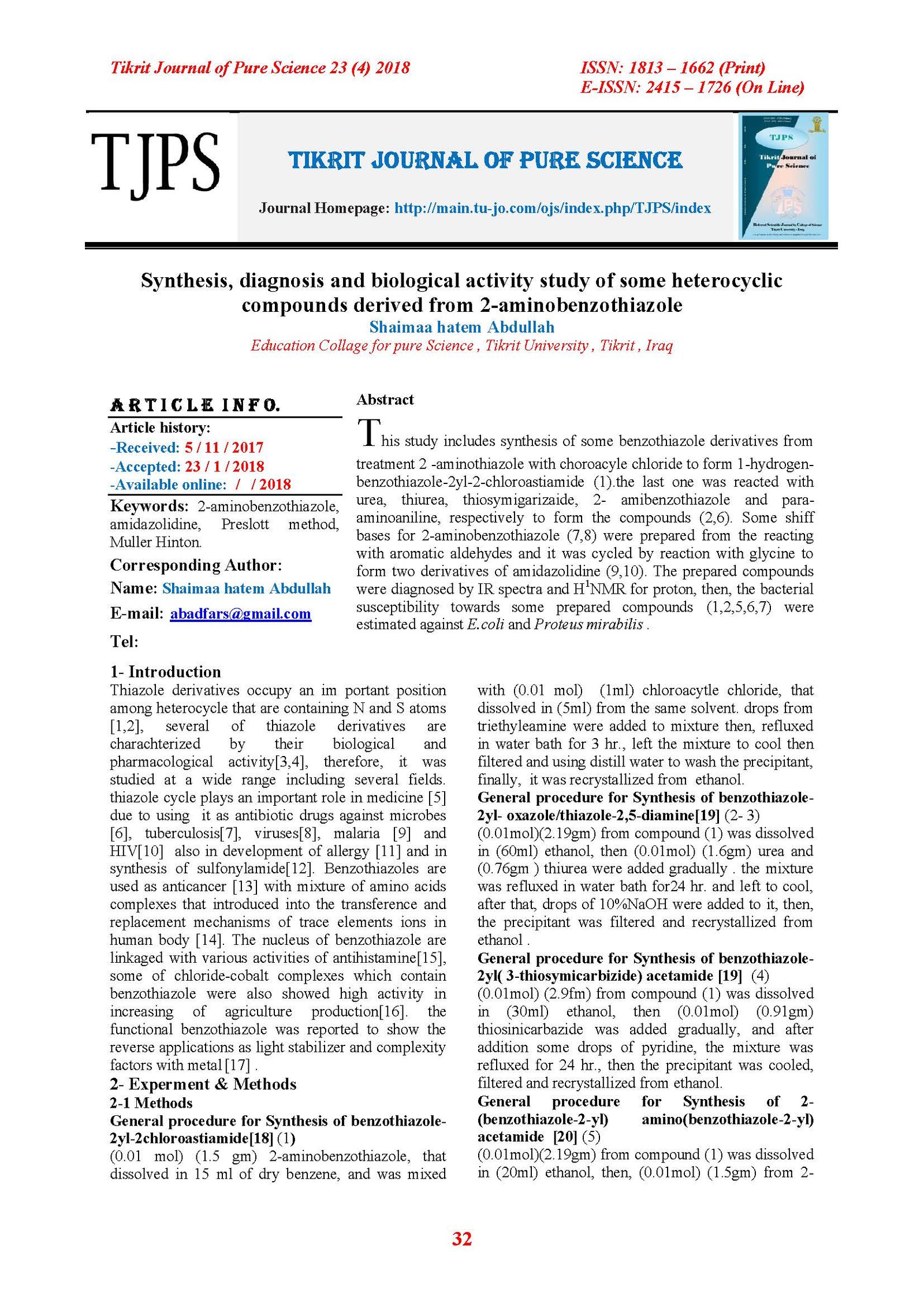Synthesis, diagnosis and biological activity study of some heterocyclic compounds derived from 2-aminobenzothiazole
Main Article Content
Abstract
This study includes synthesis of some benzothiazole derivatives from treatment 2 -aminothiazole with choroacyle chloride to form 1-hydrogen-benzothiazole-2yl-2-chloroastiamide (1).the last one was reacted with urea, thiurea, thiosymigarizaide, 2- amibenzothiazole and para- aminoaniline, respectively to form the compounds (2,6). Some shiff bases for 2-aminobenzothiazole (7,8) were prepared from the reacting with aromatic aldehydes and it was cycled by reaction with glycine to form two derivatives of amidazolidine (9,10). The prepared compounds were diagnosed by IR spectra and H1NMR for proton, then, the bacterial susceptibility towards some prepared compounds (1,2,5,6,7) were estimated against E.coli and Proteus mirabilis .
Article Details

This work is licensed under a Creative Commons Attribution 4.0 International License.
Tikrit Journal of Pure Science is licensed under the Creative Commons Attribution 4.0 International License, which allows users to copy, create extracts, abstracts, and new works from the article, alter and revise the article, and make commercial use of the article (including reuse and/or resale of the article by commercial entities), provided the user gives appropriate credit (with a link to the formal publication through the relevant DOI), provides a link to the license, indicates if changes were made, and the licensor is not represented as endorsing the use made of the work. The authors hold the copyright for their published work on the Tikrit J. Pure Sci. website, while Tikrit J. Pure Sci. is responsible for appreciate citation of their work, which is released under CC-BY-4.0, enabling the unrestricted use, distribution, and reproduction of an article in any medium, provided that the original work is properly cited.
References
1. A.Rana N. siddiqui, s. khan, s. Haque and M. bhAT, eur.J. Med. Chem, 43,114, (2008).
2. M.M. El-Ajaily, F.I. El-Moshaty, R.S. EL-Zweay and A.A. Maihub, Int. J. Chem. tech Res; 1,80, (2009)
3. E.kahyama, I. H utchinson, M Chna, S.F. Stinson, l. R Philips, G. kaur E.A. sausville, T.D bradshaw, A.D. westwell, M.F.G sterens, J.meol. chem; 42,4,72, (1999).
4. S.lau . B.sarkar, can .J. chem.; 53,7,10,(1975)
5. N.M. Parckh, K.V. Juddhawala and B.M. “Antimicrobial activity of thiazolyl benzenesulfonamide - condensed 2,4-thiazolidinediones derivatives”, Medicinal chemistry research, vol.22,no.6,pp.2737-2745,(2013).
6. M.A. Raslan and M.A. Khalil. “Hetrocyclic synthesis containing bridgehead nitrogen atom synthesis of of 3-[(2H)-2-oxobenzo [b]pyran-3-yl]-s-triazolo [3,4-b]-1,3,4-thiadiazine and thiazole derivatives“, Hetroatom chemistry, vol. 14, no.2, pp.114-120, (2003).
7. J. Banothu, K. Vaarlam, R. Bavantula, and P.A. Crooks, “sodium fluride as an efficient catalyst for the synthesis of 2,4-disubstituted-1,3-thiazoles and selenazoles at ambient tempetature“, Chinese chemical letters , vol.25,no.1,pp.172-175, (2014) .
8. K.A. Milinkevich, L. Ye. and M.J. Kurth, “ synthesis of 5-{thiazol-5-yl}-4,5-dihydroisnxazoles from 3-chloropentane -2,4-dione”,journal of combinatorial chemistry, vol. 10, no. 4, pp521-525, (2008) .
9. M.A. Gousda, M.A. Berghot, G.E. Abd El-Ghani, and A.M. Khalil, “synthesis and antimicrobial activities of some new thiazole and pyrazole derivatives based on 4,5,6,7-tetrahydrobenzothiophene moiety“,European journal of medicinal chemistry, vol.45, no.4,pp.1338-1345, (2010) .
10. P.C. Lv, K.R. Warng, Y. Yang et.al, “Design, synthesis and biological evaluation of novel thiazole derivatives as potent FabH inhibitors “, bioorganic and Medicinal chemistry lethers, vol.19,no.23, pp.6750-6754, (2009) .
11. A. Zablotskaya, J. Segal, A. Geronikaki et al, “Synthesis, physicochemical characterization, cytotoxicity, antimixrobial, anti-inflammatory and psechotroupic activity of new N-[1,3-(benzothiozol-2yl]-e-[3,4-dihydroisoqinolin-2(1H)-yl]al, karamides”, Europun journal of medicinal chemistry, vol.70, no.23,pp.846-856, (2003).
12. A.E. Smith and E. Formmel, chem . Abstr , 57, 7256a . Arzneimittel forch, 12, 485 – 7 ,(1962).
13. A. Omairi, '' Sgnthesis of some new coumairn Compounds study of their biological activity Saudi- pharm J .,3,87, (2001)
14. A. Mansour, M. Eaid and N. A. M. Khalil, Molecules, 8,744-755,(2003)
15. U. srivasture R.B Pathax and S.C. Bahel, J. indian chem ,soc. ,vol . LV III , 822 , (1981).
16. T. Ramaligam, AA Dishmukh, P.B. Saltur , U.K. Sxeth and Naik, G Indian chem . soc, 58 269, (1981).
17. H. Singh, L.D.S. Misharo, J.Inorg . nucl. chem, 43 (1981) 1701.
18. Shaaban K.mohamed A.A. Abdelhamide, walid omarac , Abdel –Aal M.Jaber and mustfa ALbayatif, Jcprc ,5(1)19-31,(2013).
19. Slobodan sukdolak, slavica soluji, Nenad vukovl, nedeljko manojlovl and ljubomir Krsti; J.serb . chem. soc ; 69(5),319-326, (2004)
20. Nazar Trotsko, Maria Doboszi and Ewajagieo W'', Jtowicz,. Acta poloniae Pharmaceution Drug; 64 (3), 227-231, (2007).
21. Panneer selvam, T.P.P. Radhikal, S. Janagaraj1 A.siva, kumer; Researchin, Biotchnology, J.chem, 2(3),50-57 ,(2011).
22. Vollnm, R.I, ''Faibrother Text book of Bacteriology, (1983).
23. Turk, D.C., and I. A., ''Medical microbiology'' Iranslated by altalib, H.A., Hniversyg of mosel. p.24; (1984).
24. Collons c.n, and patrica, m., microbiologicl methods, lyne, (1984).
25. Bauer. A.W., and kir by. w.m, Anti biotic susceptibility testing by astand ardizng single disc method, the American J.Of clinical pathology, 45 (4), 493 – 496, (1966)
